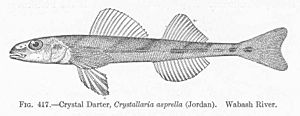Crystal darter facts for kids
Quick facts for kids Crystal darter |
|
|---|---|
 |
|
| Conservation status | |
| Scientific classification | |
| Synonyms | |
|
The crystal darter (Crystallaria asprella) is a cool, small freshwater fish. It's a type of ray-finned fish and belongs to the same family, Percidae, as perches. This little fish lives in rivers in North America, especially around the Mississippi and Ohio Rivers. Sadly, it's not found in many parts of the Ohio River anymore.
Contents
What Does It Look Like?
The crystal darter can grow up to about 12 cm (5 inches) long. It's usually olive-colored or tan. It has four dark marks on its back that look like saddles. These marks go down to its side, where it has a brownish stripe. Its belly is whitish. Crystal darters usually live for about three years.
Where Do They Live?
Crystal Darter Habitat
In the past, crystal darters lived in many places across the Mississippi River basin. This included areas from Wisconsin and Indiana all the way south to Louisiana, Mississippi, and Alabama. Today, they are much harder to find in many of these areas. They are rare in states like Wisconsin, Minnesota, Iowa, and Missouri.
Crystal darters like to live in rivers that flow quickly. They prefer water that is clear or only a little cloudy. You'll find them in areas with sand or gravel at the bottom. They don't like muddy bottoms or places with lots of plants. These fish often hide under stones or bury themselves in the sand. When they do this, only their eyes stick out!
How Do They Have Babies?
Crystal Darter Reproduction
Crystal darters lay their eggs, a process called spawning, multiple times. This usually happens from January through mid-April. Young crystal darters grow fast. They become old enough to have their own babies before they are one year old. However, they usually wait until the next year to spawn.
Female darters are ready to lay eggs when they are about 50 mm long. Males need to be a bit bigger, around 61 mm, before they are ready. Male darters grow faster and become larger than females of the same age. Females lay between 106 and 576 eggs at a time. The longer the female fish, the more eggs she can lay.
Why Do They Burrow?
Crystal darters often bury themselves in sandy river bottoms. Only their eyes stick out. Scientists think they do this for a few reasons. It might help them catch food, hide from bigger fish, or save energy.
One study looked at a similar fish, the Eastern sand darter. This study suggested that burrowing helps darters save energy. It helps them stay in place in the sandy riverbed, especially when the water is flowing very fast or very slow. This behavior is probably very important for the crystal darter too.
What Threats Do They Face?
Pollution and Habitat Loss
The crystal darter faces many dangers. Their homes are being damaged by pollution and too much dirt in the water, called siltation. Their rivers are also being changed by things like dams.
Fish like the crystal darter need clean gravel and sand to lay their eggs and find food. This means they are very sensitive to activities that cause pollution and siltation. Things like mining, logging, and agriculture can cause a lot of dirt and chemicals to get into the water.
When too much dirt gets into the water, it makes the water cloudy. This can make it harder for sunlight to reach the bottom. It can also harm the small insects that darters eat. Lots of dirt can even hurt the fish directly by clogging their gill rakers. It also makes it hard for them to lay eggs, which means fewer baby fish. Since crystal darters hunt by sight, cloudy water makes it harder for them to find food.
River Changes and Dams
Changing how rivers flow can also hurt darters. When rivers are straightened or made wider, the water slows down. Crystal darters like strong currents, so these changes reduce the places where they can live.
Dams also cause problems. They make the water slow down and cause more dirt to settle on the river bottom. This changes the riverbed where darters live. Dams also break up the fish's habitat. This means fish can't move freely between different parts of the river. If a group of fish dies out in one area, new fish can't easily move in to replace them. This can also reduce the variety in their genes, making them less healthy as a group.
How Are We Protecting Them?
The IUCN (International Union for Conservation of Nature) lists the crystal darter as vulnerable. This means their living areas are shrinking, and their habitat is getting worse.
Different states in the U.S. also have special protections for the crystal darter. For example, Minnesota and Arkansas list it as a "special concern" species. Wisconsin and Missouri list it as "endangered," meaning it's in great danger of disappearing. Illinois says it's "extirpated," which means it's no longer found there at all. Mississippi lists it as "critically impaired" because it's so rare. These listings help people know that this fish needs our help to survive.
Who Named This Fish?
The crystal darter was first officially described by an American fish scientist named David Starr Jordan in 1878. He first called it Pleurolepis asprellus. Later, in 1885, he and his colleague Charles Henry Gilbert put it into a new group, or genus, called Crystallaria.


